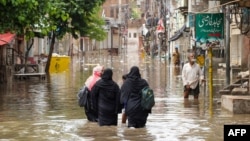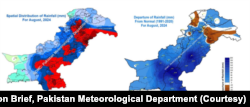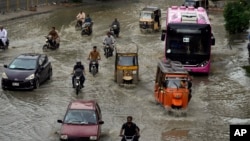As monsoon season nears its end in Pakistan, higher than average rainfall and rain-related accidents leave behind a trail of deaths, nearly half of them children.
Monsoon season runs from July to September in Pakistan. Since the beginning of July, the country has counted at least 337 rain-related deaths, according to the National Disaster Management Authority. One-hundred-seventy children are among the dead. Thousands also have been displaced as floodwaters inundated villages.
Pakistan’s meteorological department recorded rains 60% higher than average in the first two months of the monsoon season. August saw 137% more rain than the month’s average after slightly below average rainfall in July. Weather officials expect mostly normal rainfall in September.
The data shows that rainfall patterns in Pakistan are changing.
“The shift that we are seeing is that monsoon used to go to the upper areas, that trend is lessening a bit,” Sahibzad Khan, director general of PMD, told VOA. “Now it’s shifting more to the south.”
Rain that was twice as heavy as normal battered Pakistan’s two southern provinces, Sindh and Balochistan, over the last two months, while the northern, mountainous regions saw average-to-below-average rain, according to the national weather agency.
Just in Sindh, 72,000 children saw their education disrupted by the severe weather, Save the Children said in a statement Wednesday.
Despite heavy rains, flooding, and displacement in parts of the country, experts say Pakistan escaped extensive damage this monsoon season, partly because of lessons learned from the devastating floods in 2022.
“We are working more on anticipatory approaches. Looking at past patterns, we are predicting the scale and velocity of upcoming floods,” said Shafqat Munir Ahmad, deputy executive director of the Resilience Development Program and Policy Outreach at the Sustainable Development Policy Institute in Islamabad.
In 2022, historic rains submerged nearly a third of the country at one time, affecting 33 million Pakistanis and causing nearly $30 billion in damage.
Since then, Pakistan incorporated technology to plan scenarios and issue early severe weather warnings to communities, said Ahmad, adding that improved coordination and response time also reduced damage.
This year, Pakistan also used lightning detectors that China provided last year.
“China has collaborated with us. With their help, we have 26 lightning detector stations that tell us about the type and severity of lightning and thunder,” said weather chief Khan.
Pakistan still lacks sufficient long-term planning, however, to tackle the impact of climate change, experts say. The Germany-based Global Climate Risk Index ranks Pakistan the 8th most vulnerable country.
A web app created at the University of Maryland that predicts what a city’s weather will be like in 60 years shows summers and winters in several Pakistani cities will be much warmer than they are at present.
While projects to mitigate climate change may attract funding, Ahmad said efforts to help vulnerable communities adapt to changing climate lack necessary financial support in Pakistan.
Several communities across the South Asian nation are still awaiting funds to rebuild homes devastated by the 2022 weather calamity.
Just last July, the Asian Development Bank approved a $400 million loan to fund the reconstruction of homes and infrastructure in Sindh.
At a donor conference in January 2023, donors pledged more than $9 billion to help Pakistan build back after the 2022 floods. Still, the country has barely tapped the funds that were largely designated as project loans.
As authorities and charitable organizations rush to provide food, water and shelter to communities displaced by this year’s rains and floods, Save the Children urged increased support to prevent the current impact of the floods from becoming long-term problems.
“Governments must tackle the underlying causes of these climate driven disasters, including channeling funding and support to children and their families in Pakistan to adapt, recover and rebuild their lives,” the statement said, quoting country director Khuram Gondal.











